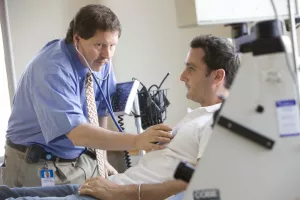Amyloidosis is a group of plasma cell diseases where misfolded proteins form clusters that build up on your tissue and organs. These clusters, known as amyloids, can harm some of the body's most important organs like the heart, kidneys and liver, as well as nerves.
What is amyloidosis?
Your body makes thousands of different proteins that aid its many essential functions. Sometimes, these proteins misfold and don’t connect with other molecules like they should. The body is usually good at recognizing when this happens and then removing them.
But when a person is living with amyloidosis, the body doesn’t regulate these misfolded proteins, which grow into clumps called amyloids. As these amyloids continue to cluster on your organs, they can cause organ damage.
There isn’t a cure for amyloidosis at this time, but there are steps we can take to manage your symptoms and protect your body from organ damage.

Conditions
Because amyloids can cluster on different organs and tissues, your symptoms will vary based on the affected body parts. Talk with your doctor right away if you begin experiencing a combination of the following symptoms:
Types of amyloidosis
There are different types of amyloidosis, like cardiac amyloidosis or AL amyloidosis. The type of amyloidosis you have depends on the affected proteins.
Immunoglobulin light chain (AL amyloidosis)
AL amyloidosis is the most common form of amyloidosis. It occurs when plasma cells in the bone marrow produce part of an antibody (an immunoglobulin light-chain protein) that damages tissue and organs. There are different kinds of AL amyloidosis, including:
- Localized AL amyloidosis
- Newly diagnosed systemic AL amyloidosis
- Relapsed systemic AL amyloidosis
Cardiac amyloidosis
For people living with cardiac amyloidosis, amyloids cause the heart to become stiff and unable to function properly. There are 2 types of cardiac amyloidosis:
- Amyloid light chain (AL)
- Amyloid transthyretin (ATTR)
The key difference between the 2 types of cardiac amyloidosis is the type of protein that builds up on the heart. There are slight differences in the symptoms, too. AL often affects the kidneys, which can cause the legs to swell. Meanwhile, ATTR almost never involves the kidneys.
Familial or hereditary amyloidosis
Familial or hereditary amyloidosis develops among people who inherit a specific gene mutation. This condition occurs when the liver produces an abnormal or mutated form of a protein called transthyretin.
Age-related amyloidosis
Age-related amyloidosis (ATTRwt) occurs in older adults when the transthyretin protein is normal or ‘wildtype’ in sequence (not mutated). Most cases of ATTRwt occur in men and assigned males at birth (AMAB) who are over the age of 70.
People living with ATTRwt may develop progressive heart failure as a result of amyloids building up on the heart.
Secondary amyloidosis (AA)
Secondary amyloidosis (AA) is a very rare condition that leads to inflammation. This condition can result from:
- Chronic Infectious diseases like tuberculosis, bronchiectasis, osteomyelitis or leprosy
- Chronic inflammatory chronic diseases like rheumatoid arthritis or granulomatous ileitis
Testing
We turn to the following tests to diagnose amyloidosis:
- Biopsy from a site rich in blood vessels, like abdominal fat
- Blood test
- Bone marrow aspiration or biopsy
- Breathing tests
- Cardiac MRI
- Echocardiogram
- Electrocardiogram
- Organ biopsy
- Organ function assessment (kidney, liver and heart)
- Physical examination
- Technetium pyrophosphate (PYP) scanning
- Urine test
Plasma cell testing
We can collect a wealth of information by performing genetic tests on your plasma cells. For example, because we know that over 95% of people living with AL amyloidosis will have a free monoclonal light chain in their blood, this is an important diagnostic indicator.
To get a detailed understanding of your condition, we’ll check your blood for abnormal proteins by evaluating your:
- Free light chains
- Protein electrophoresis
- Serum immunoglobulin levels
These tests pinpoint your amyloidosis condition and inform what treatments will offer you the greatest success at improving your quality of life.
Heart testing
Imaging tests like MRIs, echocardiograms and PYP scans provide a clear picture of your heart condition. In rare cases, we may perform a heart biopsy to determine your exact type of cardiac amyloidosis.
Staging of AL amyloidosis (AL)
Once we’ve confirmed that you’re living with AL amyloidosis, it’s important to understand if the disease is spreading and, if so, how far. This process, called staging, helps us design your most effective care plan.
The staging systems we use for AL amyloidosis focus on the potential organ damage your condition can cause. Staging tests include:
- Cardiac biomarkers: Stages the cardiac damage that patients often have at diagnosis.
- 24-hour urine collection: Stages kidney disease by evaluating the amount and type of protein in your urine.
- Standard blood tests: These determine the extent of kidney disease.
Treatments
We’re always pursuing what’s next in healthcare, and what’s next for your health. Clinical trials and research studies continue to shed light on amyloidosis, like the roles genes, plasma cells and proteins play in the disease. By unlocking answers to this complex condition, we can create new treatment therapies.
Today, treating amyloidosis can involve:
- Stem cell transplants
- Chemotherapy
- Organ transplant (kidney transplant and heart transplant)
When you trust Tufts Medicine with your health, you’ll be supported by a team of experts every step of the way:
- Hematologists
- Cardiologists
- Nephrologists
- Neurologists
Tracking your body’s response to treatment
Plasma cells produce an identifiable immunoglobulin signature with a heavy chain and a light chain. We follow these signatures during therapy because as the number of malignant cells decreases, these proteins also decrease. This is a clear sign that the person is responding to treatment.
It’s important to know that amyloidosis will require lifelong care because relapsing is common. Relapse occurs because a very small amount of the disease remains in your body even after we cannot find signature proteins in the blood or urine. This is called minimal residual disease.
We can better understand your risk of relapse by testing your minimal residual disease.

From regular office visits to inpatient stays, find the healthcare you need and deserve close to home.

Meet the doctors and care team devoted to supporting you every step of the way along your path to better health.